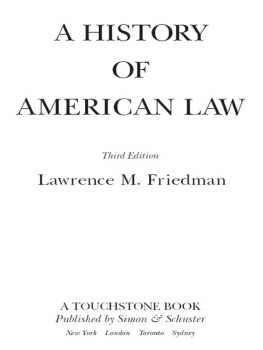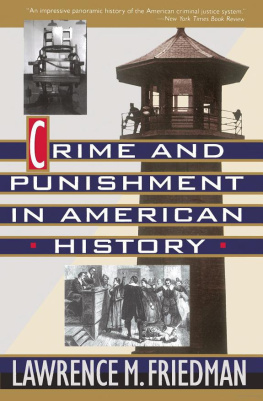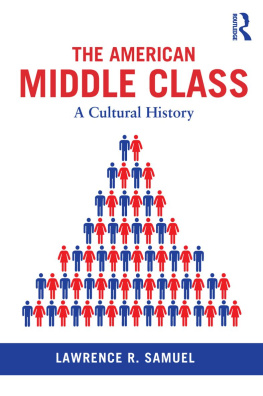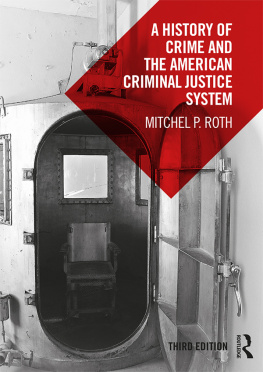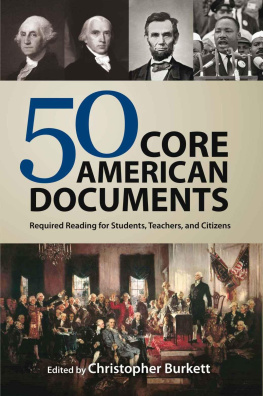TOUCHSTONE
Rockefeller Center
1230 Avenue of the Americas
New York, NY 10020
Copyright 1973, 1985, 2005 by Lawrence M. Friedman
Copyright renewed 2001 by Lawrence M. Friedman
All rights reserved
including the right of reproduction
in whole or in part in any form.
Revised Touchstone Edition 2005
TOUCHSTONE and colophon
are registered trademarks
of Simon & Schuster, Inc.
Designed by Publications Development of Texas
Library of Congress Cataloging-in-Publication Data is available.
ISBN-13: 978-0-7432-8258-1
ISBN-10: 0-7432-8258-2
Visit us on the World Wide Web:
http://www.SimonSays.com
Preface to the Third Edition
More than eighteen years have gone by since the second edition was published. In the preface to the second edition, I said that the literature had expanded like a balloon, and that it was becoming harder and harder to keep up. This is even more true today, as I write this preface, in the early years of the twenty-first century. It has become almost impossibleperhaps it is impossibleto master the whole literature. In a way, this is a gratifying fact: The field is healthy and vigorous. More and more historians and social scientists, and people in general, recognize that law is central to our lives, and to the life of our society, and always has been. Understanding how the law works (and doesnt work) is also central. Historical accounts can help us come to grips with the meaning of this vital institution. History never gives uscannot give usanswers to questions of policy, or tell us how to deal with the problems that face us. But it can clear our minds of myths and misconceptions; and it can make us think about the human condition in a richer and more nuanced way.
Here is what I have done in this edition: I reread and rethought the whole text. I tinkered with some parts of it; other parts I rewrote, either because I have changed my mind, or because new work has cast new or different light on the subject. Often, I simply felt I could improve on the way I had expressed things. I have retained the general shape and the general approach of the book. For this I make no apologies. It is still a social history of law. It still rejects any notion that law is autonomous. Law is a mirror of society. Perhaps it is a distorted mirror. Perhaps in some regards society mirrors law. Surely law and society interact. But the central point remains: Law is the product of social forces, working in society. If it has a life of its own, it is a narrow and restricted life.
I have tried to take into account, and cite, much of the important work done in the field since the second edition. But I have had to leave out a great deal, in the interests of saving space if nothing else. The main emphasis is still on the nineteenth century. I have, however, expanded the treatment of the twentieth century. What was once an Epilogue is now an independent part of the book, with six chapters. I cannot claim that this does justice to the period, but at least it comes a bit closer than the earlier editions did. In other works of mine, I have tried hard more or less to fill in this gap.
I continue to be grateful to all the wonderful scholars whose work I have used. They have worked long and hard to excavate the lost history of our legal system, to end its obscurity and isolation. They have tried to clear away the rubble and the mythsto shine a light on an ambiguous and complicated past. I also have to acknowledge a tremendous debt to the Stanford Law Library. I want to thank, in particular, David Bridgman, Paul Lomio, Erika Wayne, and Sonia Moss. They have helped me find what I wanted and needed, and have always gone the extra mile. I have had help, too, from some excellent students: Catherine Crump, Mark Jacobsen, Joseph Thompson, in particular. Mary Tye, my assistant, helped me with the manuscript, with great grace, initiative, and intelligence. And, as before, I want to pay homage to my family; and to my wife Leah, in particular, whose love and support have meant so much to me.
LAWRENCE M. FRIEDMAN
Stanford, California
June 2004
Prologue
Modern communications and technology have made the world smaller. They have leveled many variations in world culture. Yet, people still speak different languages, wear different clothes, follow different religions, and hold different values dear. They are also subject to very different laws. How different is not easy to sum up. Clearly, legal systems are not as different as different languages. The new world, the world we live inurban, industrial, technologicalcreates a certain kind of society; and this kind of society depends on and welcomes certain kinds of laws. An income tax, for example, is a common feature among developed countries. But the exact form that a tax law takes depends on the general legal culture. Americans are naturally used to American laws. Law is an integral part of American culture. Americans could adjust to very alien laws and procedures about as easily as they could adjust to a diet of roasted ants or a costume of togas. Judge and jury, wills and deeds, the familiar drama of a criminal trial, an elected assembly or council at work making laws, licenses to get married, to keep dogs, to hunt deerthese are all part of a common experience, peculiar to the United States. No other legal culture is quite like it. Presumably, no other culture fits the American system quite so aptly.
Many people think that history and tradition are very strong in American law. There is some basis for this belief. Some parts of the law can be traced back very farthe jury system, the mortgage, the trust, and some aspects of land law. But other parts of the law are quite new. The living law, the law we use every day, the law that affects us every day, including tax law, traffic codes, and social-welfare laws, is comparatively recent, on the whole. While one lawyer is advising his client how to react to a ruling from Washington, issued that very day, another may be telling his client that some plausible course of action is blocked by a statute well known to the lawyers of Henry VIII or by a decision of some older judges whose names, language, and habits would be unfathomable mysteries to both attorney and client. But the first situation is much more likely than the second. Some parts of the law are like the layers of geological formations. The new presses down on the old, displacing, changing, altering, but not necessarily wiping out everything that has gone before. Law, by and large, evolves; it changes in piecemeal fashion. Revolutions in essential structure are few and far between. That, at least, is the Anglo-American experience. Most of the legal system is new, or fairly new; but some bits of the old get preserved among the mass of the new.
What is kept of the old is highly selective. Society may be fast or slow as it changes; but in either case, it is ruthless. Neither evolution nor revolution is sentimental. Old rules of law and old legal institutions stay alive only when they still have a purpose. They have to have survival value. The trust, the mortgage, the jury are legal institutions that can be traced back centuries. But they still have the vigor of youth. They have come down from medieval times, but the needs they now serve are twenty-first-century needs. They have survived because they found a place in the vigorous, pushy society of todaya society that does not hesitate to pour old wine into new bottles and new wine into old bottles, or throw both bottles and wine away. At any rate, the theory of this book is that law moves with its times and is eternally new. From time to time, the theory may not fit the facts. But more light can be shed on legal history if one asks why does this survive than if one assumes that law, unlike the rest of social life, is a museum of accidents and the mummified past.

